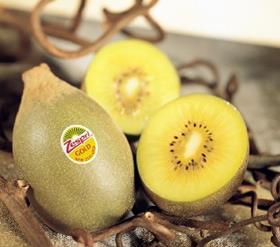
The cogs of New Zealand kiwifruit marketer Zespri’s massive PR machine have once again been set in motion.
The arrival in Zeebrugge on 3 May of Zespri’s first European shipment saw marketing activities in the region shift into gear.
The group has television campaigns planned for Spain, Italy, Belgium and the Netherlands, which will be supported with in-store promotions. These will take place predominantly in dedicated fruit retailers and involve marketing material and competitions.In Germany, Zespri will work closely with supermarket operators to undertake in-store promotions. These will be supported with an online advertising campaign on targeted websites to promote daily consumption of kiwifruit through information and competitions.
The group’s CEO Lain Jager told Fruitnet.com that while gold volumes will be down substantially on last year as a result of vine disease Psa-V, there will still be plenty of the fruit to market. “The situation is that last year we sold around 30m trays of gold fruit. This year we’ll be down to about 20m trays. But then to put this into perspective this is the same amount that we sold in the 2010 season.”
Zespri’s general manager of grower and government relations, Simon Limmer, said the European market, which typically accounts for 40 per cent of the group’s sales, will be difficult this season. “We’ve got a really challenging situation in Europe, we’ve got foreign exchange headwinds that are blowing pretty hard,” he explained. “We’re also seeing quite big supplies of fruit coming out of the Northern Hemisphere and potentially out of Chile as well. It’s probably going to be quite a late finish for the Italians and Europe in particular is probably going to be challenging for us, although we are confident that we are well positioned to get the best from the market despite these challenges.”
Limmer was more optimistic about sales into the growing Asian market. Along with mature markets in the region, such as Japan and South Korea, he said China was developing rapidly and growing at rates exceeding 20 per cent per year. “We’re seeing more disposable income, more discerning consumers and more brand-oriented consumers,” he said. “The market is huge and you’ve got to take it in bite-sized chunks, so we’re looking at the big cities on the east coast and some of the inland cities.”
Zespri is working to ensure effective infrastructure and marketing structures are in place, he adds. “We’re investing heavily in that market and we’re seeing good returns out of it.”
Sales to Japan were expected to perform well this season, despite the series of disasters, which hit the country in March of last year, said Jager. “People there are careful with electricity because nuclear power plants have been shut down and they are very focussed on saving money – but, with this said, the consumer base in Japan is robust. The reason for this is that 30 per cent of our consumers eat 80 per cent of our fruit and these are people who are less affected by economic factors and buy it because it is part of their weekly diet.”



